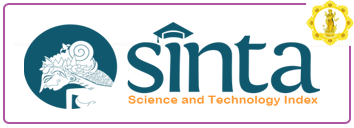CODE MIXING AS LANGUAGE STYLE IN COMMUNICATION THROUGH SOCIAL MEDIA TWITTER
Abstract
Keywords
Full Text:
PDFReferences
Al-Emran, M., & Al-Qaysi, N. (2017). Code-switching usage in social media: a case study from Oman knowledge management view project Arabic natural language processing tools view project code-switching usage in social media: a case study from Oman. International Journal of Information Technology and Language Studies (IJITLS), 1(1), 25–38. http://journals.sfu.ca/ijitls
Anastassiou, F., & Andreou, G. (2017). Factors associated with the code mixing and code switching of multilingual children : an switching of multilingual children: an overview. International Journal of Linguistics, Literature and Culture (LLC), 4(3), 2518–3966.
Jimmi, & Davistasya, R. E. (2019). Code- mixing in language style of south jakarta community indonesia. Premise: Journal of English Education, 8(2), 193–213. https://doi.org/10.24127/pj.v8i2.2219 Kurniawan, B. (2016). Code-mixing on facebook postings by efl students: a small scale study at an smp in tangerang. Indonesian JELT, 11(2),169–180. https://doi.org/10.25170/ijelt.v11i2.8 28
Leung, C. H., & Chan, W. T. Y. (2016). Sociolinguistic Phenomenon of Code Mixing in Hong Kong: From a Perspective of Marketing Communications. Humanities & Social Sciences Reviews, 4(1), 20–26. https://doi.org/10.18510/hssr.2016.41 3
Muysken, P. (2000). Bilingual speech: a typology of code mixing. Cambridge: Cambridge University Press.
Nova, M. (2018). Code Mixing in Social Media: Balinese Language, Indonesian Language, and English. IMPACT: International Journal of Research in Humanities, Arts and Literature (IMPACT: IJRHAL), 6(5), 47–58. http://www.impactjournals.us/archiv es.php?year=2018_11_2&id=11&jty pe=2&page=14
Nuraeni, B. L., Farid, M. Z., & Cahyati, S.S. (2018). The use of indonesian english code mixing on instagram captions. PROJECT (Professional Journal of English Education), 1(4), 448–453. https://doi.org/10.22460/project.v1i4. p448-453
Ongoz, S. (2018). The use of ict tools in e-mentoring: a case study. Turkish Online Journal of Distance Education, 19(4), 76–89. https://doi.org/10.17718/tojde.47165 5
Pratama, R. M. D., & Hastuti, D. P. (2020). Code mixing and code switching in twivortiare 2 novel by ika natassa. Wanastra: Jurnal Bahasa Dan Sastra, 12(2), 288–295. https://doi.org/10.31294/w.v12i2.899 6
Purnama, A. V. (2020). The perception of efl students to the use of code- switching in classroom. Jurnal Sphota, 12(2), 52–61. https://doi.org/10.36733/sphota.v12i 2.944
Safitri, L., Harida, E. S., & Hamka. (2017). The analysis of code mixing on students’ facebook: a study on facebook status and comments of the sixth semester students tbi iain padangsidimpuan. English Language Teaching and Research, I(1), 164– 175.
Samhan, A. H. (2017). Social aspects in social media: code switching and code mixing in twitter. Research on Humanities and Social Sciences, 7(18), 110–115.
Sebba, M., Mahootian, S., & Jonsson, C. (2012). Language mixing and code- switching in writing: approches to mixed language written discourse (1st ed.). New York: Routledge.
Siddiq, R. A., Kustati, M., & Yustina, L. S. (2020). Teachers’ code mixing and code switching: insights on language barriers in efl classroom. Al-Ta Lim Journal, 27(1), 80–91. https://doi.org/10.15548/jt.v27i1.606
Silaban, S., & Marpaung, T. I. (2020). An analysis of code mixing applied by indonesia lawyers club program on tv one. Journal of English Teaching as Foreign Language, 6(3), 1–17. http://repositori.usu.ac.id/handle/123 456789/18501
Sutrisno, B., & Ariesta, Y. (2019). Advances in Language and Literary Studies Beyond the use of Code Mixing by Social Media Influencers in Instagram. Advances in Language and Literary Studies, 10(6), 143–151.
Sutrisno, B., & Ariesta, Y. (2019). Beyond the use of code mixing by social media influencers in instagram. Advances in Language and Literary Studies, 10(6), 143–151. https://doi.org/10.7575/aiac.alls.v.10 n.6p.143
Syafaat, P. M. F., & Setiawan, T. (2019). An analysis of code mixing in twitter. Advances in Social Science, Education and Humanities Research, 297, 276–281. https://doi.org/10.2991/icille- 18.2019.57
Syafrizal, & Sari, A. R. (2017). Code mixing in students’ twitter status at sultan ageng tirtayasa university in banten, indonesia. European Journal of Foreign Language Teaching, 2(1), 117–135. https://doi.org/10.5281/zenodo.3456 22
DOI: https://doi.org/10.25078/yb.v4i2.2775
Refbacks
- There are currently no refbacks.
Yavana Bhasha : Journal of English Language Education is indexed by

Yavana Bhasha : Journal of English Language Education site and its metadata are licensed under CC BY-SA



